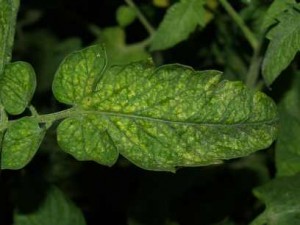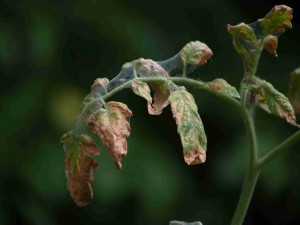Tomatoe Woes
by Keith C. Hansen
 T
here’s nothing like biting into a fresh, juicy, fully ripened tomato, right out of the garden. They are productive, fast-growing, and just a few plants, or even one, meet the needs of a typical family. No wonder they are one of the top vegetables grown in the home garden.
T
here’s nothing like biting into a fresh, juicy, fully ripened tomato, right out of the garden. They are productive, fast-growing, and just a few plants, or even one, meet the needs of a typical family. No wonder they are one of the top vegetables grown in the home garden.
During hot, dry weather, there are at least 2 major problems that commonly occur nearly every year. The first is blossom end rot. When it starts getting hot and dry, and tomatoes are getting big, it is very common for them to develop a dry rot at the base of the fruit. It’s not a disease, and can be fixed with some good gardening practices. Click here for a little more information.
 Yellowing then dying leaves often indicates spider mites. These nearly microscopic critters multiply faster than rabbits! When it is hot and dry, the 2-spotted spider mite can go from egg to egg-laying adult in as little as 10 days. Adult females can lay over 100 eggs in just a few weeks. Spider mites damage plants by breaking into plant cells and sucking out the cell contents. This results in a yellow stippled pattern which will be your first sign your plants are infested.
Yellowing then dying leaves often indicates spider mites. These nearly microscopic critters multiply faster than rabbits! When it is hot and dry, the 2-spotted spider mite can go from egg to egg-laying adult in as little as 10 days. Adult females can lay over 100 eggs in just a few weeks. Spider mites damage plants by breaking into plant cells and sucking out the cell contents. This results in a yellow stippled pattern which will be your first sign your plants are infested.
 Flip the leaves over, because that’s where the mites are feeding. The stippling there will be whitish. Unless you’re under 40 years old and have 20/20 vision, you need a hand lens to see these critters. Another easy way to detect them is to take a suspect leaf and gently rub the bottom across a white sheet of paper. Reddish streaks indicate the presence of mites. Like in this photo, fine webbing can be seen in just the right light; the arrow is pointing to a couple of mites on the underside of this tomato leaf (click photo to enlarge).
Flip the leaves over, because that’s where the mites are feeding. The stippling there will be whitish. Unless you’re under 40 years old and have 20/20 vision, you need a hand lens to see these critters. Another easy way to detect them is to take a suspect leaf and gently rub the bottom across a white sheet of paper. Reddish streaks indicate the presence of mites. Like in this photo, fine webbing can be seen in just the right light; the arrow is pointing to a couple of mites on the underside of this tomato leaf (click photo to enlarge).
The most common type on tomatoes is the twospotted spider mite. It will be a pale color with 2 spots on either side, or a orangish color. Under stronger magnification, you can also see their eggs, and the fine webbing they produce.
 When they get totally out of control (like this photo) you can easily see the fine webbing, and the dying plant is destined for the trash can - do not compost it.
When they get totally out of control (like this photo) you can easily see the fine webbing, and the dying plant is destined for the trash can - do not compost it.
So the next question is, “How do I control them”? Spider mites like it hot and dry, so a periodic syringing of the foliage can go a long way to keeping populations low. Texas A&M AgriLife Extension Horticulturist Skip Richter is a big fan of using strong blasts of water to penetrate webbing and knocking off adults and eggs. Here is a video clip of him demonstrating this technique.

